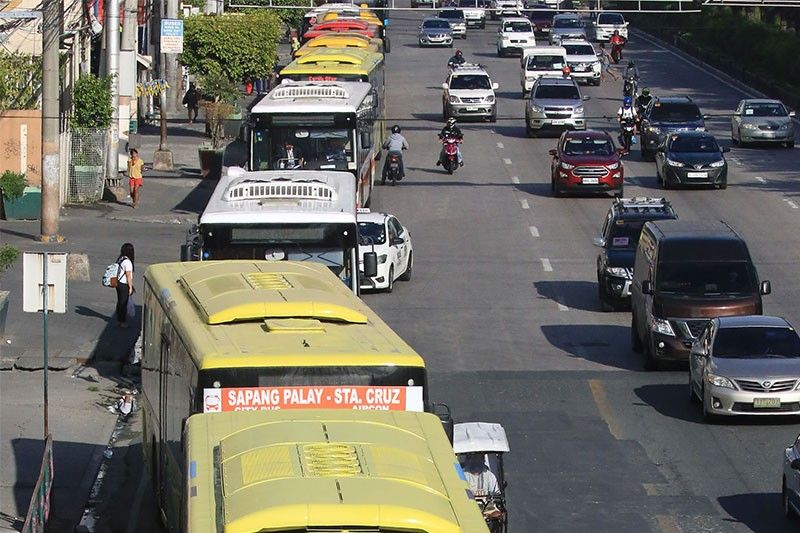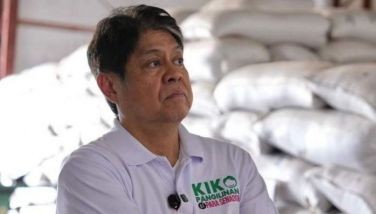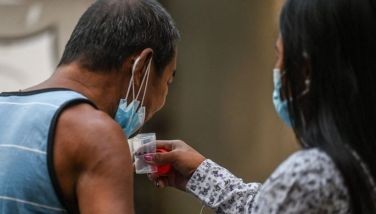Advocates ask DOTr: Are PWDs part of EDSA bus plan design?

MANILA, Philippines — Advocates and commuters reminded the transportation department to include vulnerable sectors, particularly persons with disability, in its plans for transportation in the 'new normal' post-lockdown.
At a webinar hosted by the Move as One coalition and attended by ranking execs within the transportation department, one highlight of Department of Transportation's disclosed plans was the new EDSA bus system, which will put buses in a dedicated median lane.
Although this was lauded by commuters, PWD advocates asked that they be included in the decision-making process for any transportation reforms moving forward.
READ: EDSA reform plan bared with no budget details
“The plan sounds very exciting and will likely improve the movement of people along EDSA,” Alyansa ng may Kapansanang Pinoy, Inc. (AKAP Pinoy) and person with disability advocate Dr. Maureen Mata said in a statement sent to reporters.
"It is my fervent desire, however, that we keep in mind the needs of persons with disabilities, older persons, pregnant women, and mothers with children when we design the bus stops. Let us ensure that we create at-grade crosswalks for the bus stops."
Disability in the time of coronavirus
Mata, an amputee who lost her leg to bone cancer, is herself a commuter.
Pre-COVID-19, commute consisted of taking a jeep to Guadalupe, where she is forced to take an elevated crosswalk, and where she waits for MMDA personnel to assist her as she gets onto a bus to her workplace in Quezon Avenue.
The whole ordeal takes at least two hours, she says.
Throughout the enhanced community quarantine, the disability community has struggled to get by both indoors and out: in quarantine, some have reported that they have largely not received the aid to keep them indoors.
Under quarantine rules, persons with disabilities along with senior citizens and pregnant women are still prohibited from going outdoors due to their being more susceptible to transmitting the new pathogen.
In an earlier statement issued in March, the Commission on Human Rights expressed concern over the possible effects that COVID-19 containment measures, which include the enhanced community quarantine and social distancing, could have on the disabled.
"People with mobility impairment find it hard to get aid from their local barangay as they do not have access to transportation. This is especially challenging to pregnant and elderly women with disabilities who could not go to medical clinics and hospitals for check-ups because care providers cannot accompany them due to physical distancing policies," the commission said.
“This has disadvantaged the poor and vulnerable, excluded those with disabilities and ultimately led to more traffic congestion,” the coalition added in its statement.
Arthur Tugade, who sits as the secretary of the transportation department, has said in the past that if the temporary transformation proves viable, the department will implement it permanently.
Existing laws for mobility
In a phone call, Mata also pointed to the decades-old Batas Pambansa 344 or “An Act to Enhance the Mobility of Disabled Persons by Requiring Certain Buildings, Institutions, Establishments and Public Utilities to install Facilities and Other Devices.”
Approved back in February 1983, the law provides that public utilities "shall install and incorporate in such building, establishment, institution or public utility, such architectural facilities or structural features as shall reasonably enhance the mobility of disabled persons such as sidewalks, ramps, railings and the like."
This is "in order to promote the realization of the rights of disabled persons to participate fully in the social life and the development of the societies in which they live and the enjoyment of the opportunities available to other citizens," the act reads in Section 1.
The same section continues:
If feasible, all such existing buildings, institutions, establishments, or public utilities to be constructed or established for which licenses or permits had already been issued may comply with the requirements of this law: Provided, further, That in case of government buildings, street and highways, the Ministry of Public Works and Highways shall see to it that the same shall be provided with architectural facilities or structural features for disabled persons.
Batas Pambansa 344 is among the principal laws invoked by advocates.
Though the last existing census on the disability community in the country was conducted in 2010, a 2017 study by the Philippine Institute for Development Studies of 1,031 adult women and 823 children with disabilities in two cities, majority of respondents were found to be mobility-impaired (39.7%).
"Since we’re on MECQ right now and GCQ is coming soon, our concern right now is that if this is used in the LRT and MRT stations, see to it that we can still easily go up and aren’t given a hard time doing so. I hope the elevators and ramps are in order too," Mata said.
"Second, we hope the coaches and we hope coaches and buses will have reserved spots for PWDs. Persons with disabilities should be in the front row, this is more for physical disability to be near the door of the buses or the coaches. More of reasonable accommodations," she added.
Mata also called attention to interconnectivity between modes of transportation, citing this as one front that all too often saw persons with disabilities struggling with mobility.
She cited instances of persons with disabilities and other vulnerable sectors experiencing difficulties and barriers in public transport being forced to cross via elevated crosswalks or stairs that are not accessible to then.
'Current policies disadvantage the vulnerable'
In an earlier interview with Philstar.com, transport planner Robert Siy, who is part of the coalition, said this affected Filipinos at large, saying: "It’s not so well integrated right now. I would say we need to have a careful reassessment of our public transport services."
"It's sometimes difficult to transfer [because] they are not well integrated with each other... In other countries, within the same train station, you can easily transfer from one train line to the other," he said.
"It’s not only about the way the stations are designed, but it’s also even the fare system. We already have a single beep card that you can use in all the lines, but we still have not integrated the fares," he added.
Mata said that among the proposals being lobbied for by AKAP-Pinoy was mobility within local governments.
"Since we aren’t allowed to go outside our houses in the new normal, what many PWDs suggest is how can we be able to go from one place to another? What if I need to go to the market or the barangay hall? So maybe they can look into e-trikes subsidized by local governments," she said.
In an open letter to the transportation and public works departments, the coalition said that as it stands, the current public transportation system was not doing vulnerable sectors any favors.
"Our current policies aimed at increasing motor vehicle speeds on main roads have made other public transport modes, walking, and cycling more difficult. This has disadvantaged the poor and vulnerable, excluded those with disabilities, and ultimately led to more traffic congestion," the open letter read.
"The design of pedestrian infrastructure should be guided by safety, accessibility, and inclusivity considerations. Elevated footbridges are explicitly discouraged in the transportation and urban design field because of safety concerns. The reliance on elevated footbridges also excludes over 10% of the population who are unable to climb stairs," it added.
"Transportation and mobility is perhaps the most serious issue affecting ordinary people. So many people live in cities but our cities are becoming more and more unlivable because of traffic and pollution. If we made public transport easier to use, life would become better for so much people," Siy said.
- Latest
- Trending































